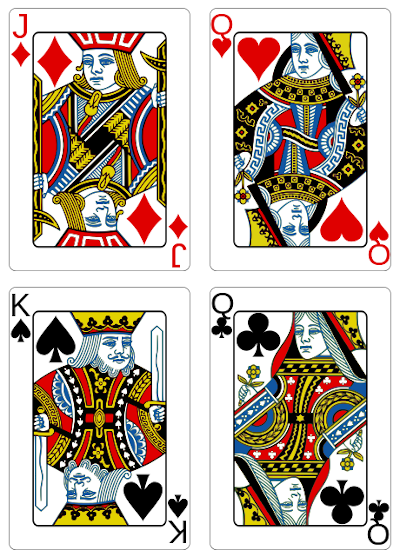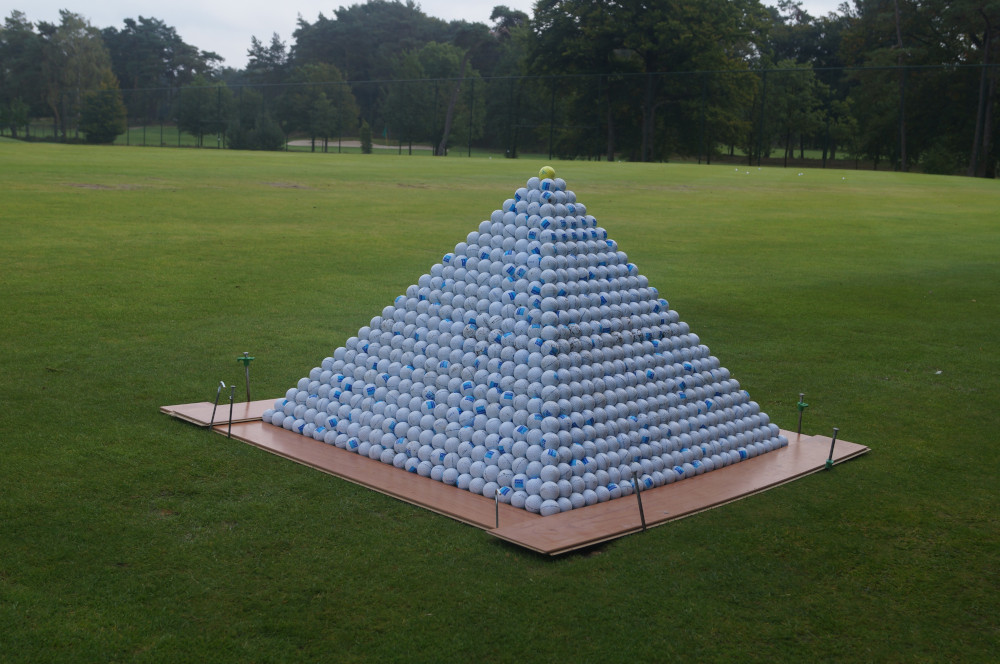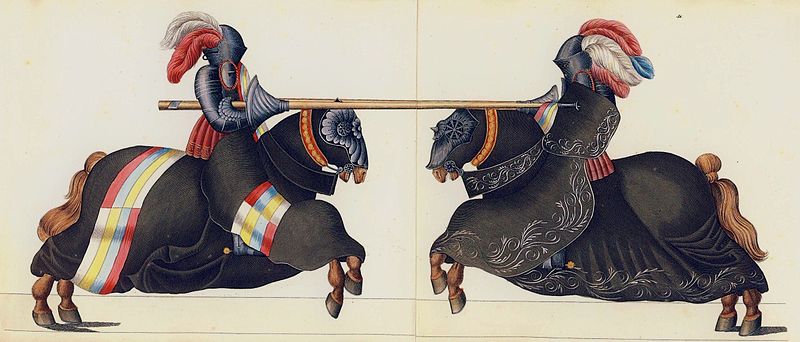
Choose one of these cards and fix it clearly in your mind. Then open the answer box.

Choose one of these cards and fix it clearly in your mind. Then open the answer box.
Suppose you want to hang a picture by a string that’s attached at two points on the back of the frame. How can you arrange the string on two nails such that the picture will fall if either nail is removed?
One solution is above. I don’t know who first asked the question; I first saw it in Mathematical Mind-Benders, by Peter Winkler, who got it from Giulio Genovese, a mathematical graduate student at Dartmouth, who’d seen it in more than one source in Europe.
But it opens up a surprisingly rich discussion — see the paper below for some entertainingly complex variants.
(Erik D. Demaine et al., “Picture-Hanging Puzzles,” Theory of Computing Systems 54:4 [2014], 531-550.)
541993 = 159211275242599 and 15921 + 12752 + 42599 = 71272
712723 = 362040234715648 and 36204 + 02347 + 15648 = 54199
(From Edward Barbeau’s Power Play, 1997.)
One other interesting detail from In Your Face, psychologist David Perrett’s 2010 exploration of human attraction. Perrett’s Perception Lab recruited 300 men and 400 women, all of whom had heterosexual partners and had been raised by two parents. They learned that romantic partners tend to look alike — the participants and their partners tended to have similar hair color and similar eye color.
This might be explained by a self-similar preference or narcissism, but on looking deeper into the data Perrett’s team found that the single best predictor of one’s partner’s eye color was the eye color of one’s parent of the opposite sex. If a woman’s mother had blue eyes and her father had brown eyes, she would most likely be partnered with a brown-eyed man. If a man’s mother had blue eyes and his father had brown eyes, his partner most likely had blue eyes. Similarly, the hair color of a man’s mother was the single best predictor of his partner’s hair color. “These results indicate that individuals choose partners who resemble their opposite-sex parent both in eye and hair color.”
(Anthony C. Little et al., “Investigating an Imprinting-Like Phenomenon in Humans: Partners and Opposite-Sex Parents Have Similar Hair and Eye Colour,” Evolution and Human Behavior 24:1 [2003], 43-51.)
Éric Angelini devised this progressively self-inventorying array:
10 71 32 23 14 15 16 27 18 19 20 81 72 53 44 35 26 47 38 29 40 101 82 73 64 65 56 77 58 39 60 131 92 93 74 75 86 107 88 69 80 201 122 113 84 85 96 117 138 89
The first line describes its own contents: It contains one 0, seven 1s, three 2s, and so on.
In the same style, the second line describes the joint contents of lines 1 and 2.
And so on: The fifth line describes the contents of the whole table: It contains eight 0s, twenty 1s, twelve 2s, etc.
He suspects that a six-line table is possible, but he hasn’t found one yet.
(Thanks, Éric.)
12 + 22 + 32 + … + 242 = 702
This is the only case in which the sum of the first k perfect squares is itself a square.
03/23/2020 UPDATE: Reader Pieter Post made a pyramid of 4900 golf balls in the Netherlands last summer:

It took him an hour and a half. (Thanks, Pieter.)
In a 1988 experiment with 2-year-olds, psychologist Alan Leslie asked each child to “fill” two toy cups with imaginary “juice” or “tea” from a bottle. Leslie then said, “Watch this!”, upended one of the cups, shook it, and replaced it next to the other cup. Then he asked the child to point to the “full cup” and the “empty cup.” Though both cups had been empty throughout, all 10 of the 10 subjects indicated that the “empty” cup was the one that had been inverted.
“This leads to pretending something that is true, namely, that the empty cup is empty,” Leslie wrote. “At first glance, this may seem ridiculous. But there is, of course, an important difference between the empty cup is empty and pretending (of) the empty cup ‘it is empty.'” Children distinguish between pretense and reality even when the content of those beliefs is the same.
“These examples help us realize that, far from being unusual and esoteric, cases of ‘non-counterfactual pretence’, that is, pretending something is true when it is true, are ubiquitous in young children’s pretence and indeed has an indispensable role in the child’s ability to elaborate pretend scenarios.”
(Alan M. Leslie, “Pretending and Believing: Issues in the Theory of ToMM,” Cognition on Cognition [1995], 193-220.)

In studying the attractiveness of human facial features, University of St Andrews psychologist David Perrett found that femininity in female face shape was preferred across cultures and by both men and women. Surprisingly, he found that masculinity in male faces makes them less attractive — in fact, people prefer male faces with a slightly feminized shape. Evaluators said that images of male faces that had been artificially masculinized looked less kind, less emotional, colder, less honest, less cooperative, and less likely to be a good parent. Feminization of male faces had the opposite effect.
This has some basis in real life, where men with more masculine faces show more aggressive and more uncooperative behavior:
Men with masculine face proportions commit more fouls in ice-hockey games and end up with a greater number of time-out penalties than men with more feminine facial proportions. Off the pitch, in an experimental set-up in which players can gain resources, defend them, and steal from others, men with masculine facial proportions choose to retaliate aggressively when other players steal from them and then to steal right back. In contrast, men with feminine facial proportions are more likely to build defences against further infringement. Furthermore, men with high testosterone (that is, those likely to have a masculine facial appearance) have more troubled relationships, and show increased rates of infidelity, violence, and divorce. Masculine males, it seems, are more likely to behave like cads than be good dads.
Men with masculine features do tend to be perceived as stronger and more dominant, and they do tend to be physically strong. Some studies have found a preference for a slight degree of masculinity, but this effect is neither dramatic nor consistent. And “no one has found an overall preference for a high degree of facial masculinity.”
(From Perrett’s 2010 book In Your Face: The New Science of Human Attraction.)

The Cook pine, Araucaria columnaris, leans toward the equator. In 2017 botanist Matt Ritter of California Polytechnic State University noticed that pines growing in California and Hawaii leaned south; he called a colleague in Australia, who reported that the trees there leaned north.
“We got holy-smoked that there’s possibly a tree that’s leaning toward the equator wherever it grows,” Ritter told Nature.
In both hemispheres, the trees lean more sharply the farther they are from the equator. The average incline is 8 degrees, but one tree in South Australia leans 40 degrees.
The reason isn’t clear; it “may be related to an adaptive tropic response to the incidence angles of annual sunlight, gravity, magnetism, or any combination of these,” the authors write. But “It’s a shockingly distinct pattern,” Ritter said.
See Beef Tack.
(Jason W. Johns et al., “Worldwide Hemisphere-Dependent Lean in Cook Pines,” Ecology 98:9 [2017], 2482-2484.)